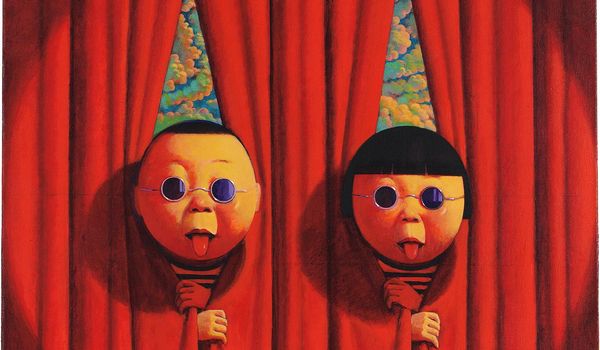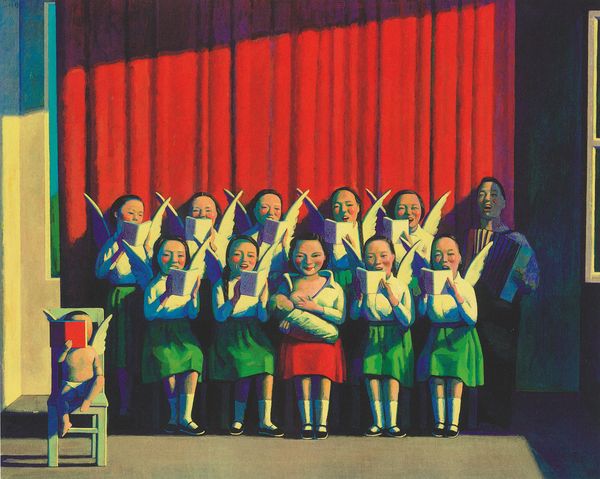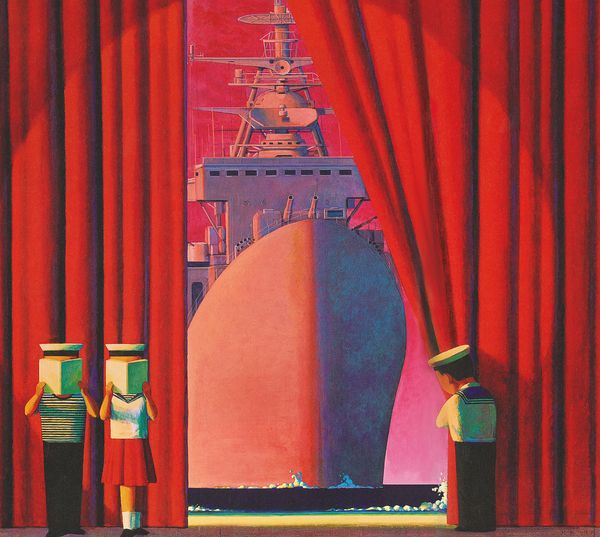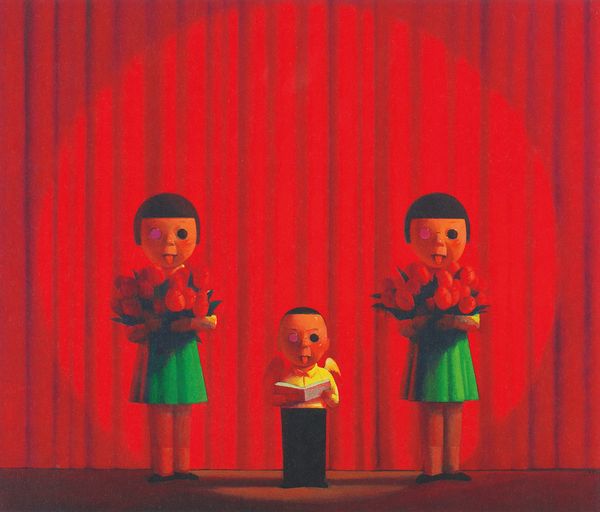Liu Ye Untitled, 1997
Known for adopting features of a chubby toddler and injecting his works with an innately cartoonish air, Liu Ye created Untitled in 1997, three years after his return from Berlin to China, just as the artist began to progress in his own terms by holding his first solo exhibition at the Ming Jing Di Gallery in Beijing.
Upon Liu's return to Beijing in 1994, he began using the color red substantially in his works. Untitled comes from Liu's compelling body of works that feature an iconic motif – the red curtain. Painted with a delicate gradient of reds, the curtain dominates the canvas further and serves as the backdrop of the scene. A sense of volume is created through the precise, undulating use of light and shade.
In spite of the many connotations one can associate with the red hue featured in Untitled, it is key to note that Liu's time in Berlin took the artist out of China at a pivotal moment in its recent history, allowing him to watch events unfold from a Western perspective and his work to develop independently from a political standpoint. Red thus serves as a color that Liu returns to in memory of his childhood, where it was once the only choice of color in a world of red leadership, yet through his painting, the shade of red attains freedom. It is no longer the political color it once was, but here it is treated abstractly in the form of a stage curtain, becoming a bearer of meanings from a wide sphere of time and space. Setting the scene upon a theatre stage, this locus rouses one's imagination as Liu Ye conjures up dreams and carries us away from reality. The theatre was an environment that Liu was closest with during his early childhood days: it served not only as the place where his father's plays for children were performed but was also used for red propaganda in the form of revolutionary operas or choir performances in a wider societal context.
Liu Ye Beijing Madonna, 1995
The artist's earliest thematic treatments of the theatre's stage begin in Beijing Madonna (1995), featuring choir members as rounded cherubs with wings, performing in front of the red curtain with a distinct sense of order. Liu puts an emphasis on the children, placing them in the foreground of the composition and, in turn, giving the red curtain a role similar to that of a stage prop. We see more significance given to the red curtain in his naval ship series, Untitled (1997-98).
Liu Ye Untitled, 1997-1998
However, it is in Untitled from our Hong Kong 20th Century & Contemporary Art Evening Sale that we see Liu's first real attempt in addressing the motif of the red curtain as an integral part of his composition and elevating it to assume the role of a protagonist in its own right. The depiction of a curtain is symbolic and can often be alluded to the act of concealing, but in Untitled we see a possibility of the artist's self-discovery. By playing with the circular shape of the spotlight against the squared composition, it creates spatial imagination, bearing resemblance to Tondo art, or black-and-white silent films, where a blackout would appear, leaving the main character in focus. The artist returns to this theme of the stage in Poet (1999). This period saw one of the artist's most important series with the frequent utilization of the color red since his return to Beijing. The motif of the curtain re-emerges in his works after 2000 but sees an artistic shift where he moves away from red and begins to use more bluish and greenish hues.
[The character of a young boy] represented his love for the comedic genre through his infatuation with actors such as Stephen Chow, Charlie Chaplain and Buster Keaton.
Untitled is a far more playful rendition of the stage theme compared to the other works in the series, where a spotlight highlights two little cherubic toddlers, sunglasses in place, poking their heads out from the curtain and mischievously sticking their tongues out; revealing a fragment of an outdoor scenery with a glimpse of blue and pink skies. Liu preserves his own image in Untitled in the form of a little boy on the left—bearing a striking resemblance to the artist. Liu first began incorporating the character of a young boy with sunglasses in the early 1990s, as seen in Interior (1993), which represented his love for the comedic genre through his infatuation with actors such as Stephen Chow, Charlie Chaplain and Buster Keaton. Liu's characters were dressed in striped shirts, suggestive of the attire that was very common for younger children in the west in the mid-to-late 1990s—the golden age of Disney films. The artist always had a fascination for the world of fairy tales, harkening back to his childhood days having been born to a father who was a children's playwright, and discovering a big black chest of Western storybooks under his bed. Perhaps the only glimpse of the outdoor scenery we have is, in fact, a window to the artist's discovery of self through a nostalgic looking back into his past.
Liu Ye Poet, 1999
Born in Beijing in 1964 and growing up against the backdrop of the Cultural Revolution, Liu spent most of his childhood living a censored and audited life in the countryside with his father, but found freedom in the form of the storybooks hidden by his parents. He came to love Oscar Wilde's The Picture of Dorian Gray, which tells the story of an artist becoming infatuated with the youth and beauty of the subject of his full-length portrait, thereby selling his soul to ensure that the portrait, rather than himself, will age and fade. The story lays the seeds for Liu's artistic style in the years to come and is the very reason why Liu never fails to plant upon his characters a sense of eternal childlike innocence, with their rotund faces, ruddy cheeks and short statures—the cartoonish features of cherubic children. But beyond these childlike characteristics, Liu conveys an attitude of life. By returning to the imaginations and fantasies of his younger self through the little boy and girl in Untitled, Liu sheds the mask and outer garments of adulthood, restoring himself to the state of a dreamy child deep in thought.
Untitled is an exceptional early work in the artist's oeuvre and references one of Liu Ye's most iconic images. It stands alone with the artist's most personal vision eloquently laced with the political environment that he grew up in, yet fully shows his first-hand understanding of Western art and culture. We would like to thank Liu Ye for his assistance with this article.



